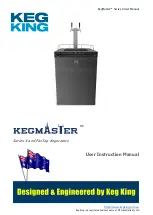
Rev 14.0/5-13
29
MRTA6-DC: #35072
V
ACUUM
S
WITCH
A
DJUSTMENT
Vacuum Switch Function
20
A vacuum switch controls the low vacuum warning light and the vacuum pump (see OPERATING
FEATURES for location of vacuum switch): The valve handle activates the warning light and the
pump, which evacuates the vacuum pads.
21
After the lifter attains a vacuum level sufficient for
lifting the maximum load weight (hereafter, “minimum lifting level”), the vacuum switch
automatically turns off the pump and the warning light.
22
In order to maintain sufficient vacuum,
the vacuum switch automatically turns on the pump and warning light again before vacuum
decreases to a level that is lower than the minimum lifting level.
Conditions Requiring Readjustment
At the factory, the vacuum switch is set to maintain the minimum vacuum level specified for the
Load Capacity (see SPECIFICATIONS). However, shipping vibrations or shocks, normal wear, or
other conditions may adversely affect this adjustment. Periodically verify the switch adjustment
by comparing how the vacuum pump and the low vacuum warning light function in relation to
the vacuum level registered on the vacuum gauge, as follows:
• If the pump and the warning light do not
turn off after vacuum increases to a level much higher
than the minimum lifting level, the vacuum switch may be adjusted to maintain a lower
vacuum level. Otherwise, the pump would continue to run unnecessarily after the lifter has
attained sufficient vacuum to lift the maximum load weight.
• If the pump and the warning light do not
turn on before vacuum decreases to a level lower
than the minimum lifting level, the vacuum switch
must be adjusted to maintain a higher
vacuum level
.
23
Otherwise, the lifter would not maintain sufficient vacuum to lift the
maximum load weight.
20
Lifters equipped with the Dual Vacuum System have 2 vacuum switches. Directions are the same for these lifters
except
that each vacuum switch must be tested and adjusted individually
. When you are evaluating vacuum system functions
under Conditions Requiring Readjustment, remember that each vacuum switch corresponds with one vacuum gauge and one
vacuum circuit. After you have removed the cover from the enclosure with the vacuum switches, you can trace the vacuum lines
to determine which components are connected to one another.
21
If the warning light does not turn on when the valve handle is moved to the “APPLY” position, the light bulb may be burned
out. Replace the bulb when necessary.
22
When using the lifter at high elevations, reduced atmospheric pressure may prevent the vacuum generating system from
attaining the vacuum level set at the factory. In this case, the pump would continue to run and the warning light would stay
illuminated continuously. If the ability to lift the maximum load weight is not required, the operator can adjust the vacuum switch
to maintain a lower vacuum level, allowing the pump to cycle normally. However, be advised that
lifting capacity decreases
proportionally with decreasing vacuum
, based on the vacuum level specified for the Load Capacity (see SPECIFICATIONS).
For example, if a lifter's Load Capacity is rated at 16" Hg [-54 kPa], lifting capacity decreases by 6.25% for each inch of Hg
subtracted from (or for each 3.4 kPa added to) the vacuum level.
Always maintain a minimum vacuum level of 10" Hg [-
34 kPa]
, regardless of the vacuum level specified for the original Load Capacity. In addition, lifter markings should be adjusted
to reflect the revised Load Capacity and the vacuum gauge should be marked to indicate the revised minimum lifting level.
23
In order to observe lifter functions while vacuum is decreasing, it may be necessary to create a controlled leak in the vacuum
system (eg, by breaking the seal between one or more vacuum pads and the test surface).
Summary of Contents for MRTA610DCO
Page 2: ......





































